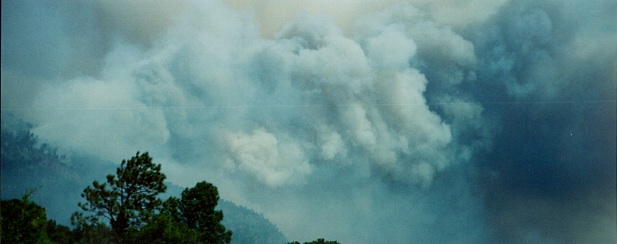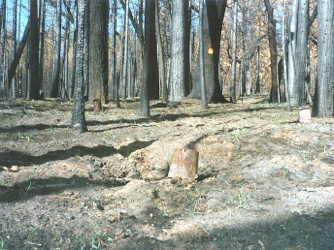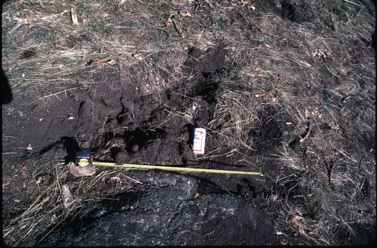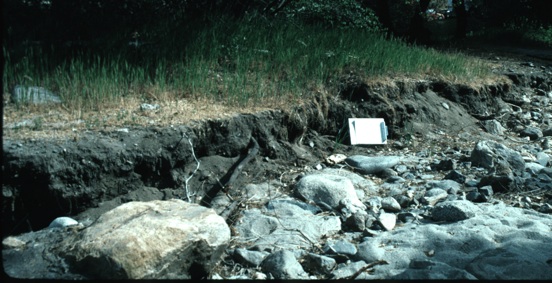Fire has effects on the biotic and abiotic components of an ecosystem. The biotic component consists of the both faunal and floral. The abiotic component, particularly soil, through both direct contact of flames with the soil and fires effects on the plant community using the soil (Hart et al. 2005).
Indirect fire effects include intentional and inadvertent looting, increased erosion of soils that can remove or bury archaeological resources, increased tree mortality resulting in impacts from tree fall or uprooting, increased rodent and insect populations that can alter subsurface soil structure, increased microbial activity, which can feed on organic matter within archaeological soils, and the addition of “new” carbon, which can be move through the soil column of archaeological sites through a variety of agents.
Increased Surface Runoff and Erosion
Following fires one moderate- to high-intensity that reduce vegetation and litter cover from 75% to 10% can resulting in increased surface runoff, up to 70 percent higher than normal, and erosion, up to 300 percent higher than normal.

A water-repellent, or hydrophobic, layer sometimes forms on, or just below, the ground surface following a fire, exacerbating the impact of even moderate rainfall (DeBano, Rice, and Conrad 1979:13-14; Wells et al. 1979:18-19).
Sheet erosion can relocate cultural materials (e.g., Rick 1976; Schiffer 1987). Localized heavy downpours were capable of produced a puddling effect, concentrating flaked-stone debitage into pools that might later be mistaken for activity areas (Wettstaed 1993; Wettstaed and LaPoint 1990). In more extreme situations, the collection of water in geologic formations can result in landslides, which can relocate or bury cultural resources.
Here are some different types of erosion:

Activated gully down-cutting process, due to fire effects on watershed, may include burned-out logs in channel, soil piping due to burned-out stump(s), lateral channel migration due to boulder deposit. Artifact migration may be due to increase in stream flow or increased energy of stream flow, threat to site features.
Rilling is a small gully system that delivers considerable sediments to site features on hill slopes and ridges that might other wise be safe.

Overland Runoff: The saturated soils are more easily eroded, and rain-on-snow events can produce massive runoff. Describe flow path to site features: (azimuth that flow approaches from; slope gradient and slope length, effective soil cover in %, fire effects on flow path and flow path watershed) Features, eroding soil away may include artifact migration off site to a channel.

Channel Debris. The feature may be damaged or threatened by flood scour when a large tree falls across the channel downstream, causing an accumulation of rock and rubble on the log. The mound of rock and rubble migrates upstream with each subsequent flood and for as long as the tree trunk forms a dam across the channel. The stream can divert to one side or the other, and often diverts to both sides of the debris cone. Stream can be diverted into the feature or across the site.

Tree Root Erosion: Increase erosion due to stumpholes and burn log channel. The integrity of the site can also be compromised by tree root canals created by burned-out roots. As water fills stump cavity, the root canals can cause soil piping.
Pedestalling: Pedestals usually form where erosion has cut away all the soil from a surface except where it is protected by artifacts, rocks, plants, roots and the canopy of the tree. It is normal that there be some channeling of water between pedestals unless the downcutting is very pronounced, such areas should not be characterized as gulling.

Trees killed or severely weakened by fire are susceptible to collapse. If archaeological resources are located near or among a stand of weakened trees any collapse could cause severe damage by the upheaval of root systems, or crushing by the trunk or main branches. Subsurface features and artifacts also can be damaged by branches being driven into the soil as the tree impacts the surface. Finally, fallen trees comprise heavy fuels that will burn at extreme temperatures during a future fire event.
Increased Burrowing Rodent and Insect Populations
Burrowing animals, particularly those that reside and feed mostly underground (e.g., gophers, earthworms), can cause considerable horizontal and vertical movement (usually within the first 2 meters of the soil column) of soils and cultural artifacts. The creation of burrows, nests, tunnels and runs can result in obscuring soil stratigraphy or other subtle features, separating and combining unassociated items, moving older artifactual materials to younger stratigraphic proveniences or younger artifactual materials to older proveniences, as well as physically alter artifacts and ecofacts through abrasion or breakage.
Carbon Contamination

The possible incorporation of recent charcoal fragments (through the action of fire itself [e.g., burned tree roots] and/or subsurface disturbances [e.g., rodent burrowing]) resulting from prescribed or natural fire into archaeological contexts, and the opportunity to submit small charcoal fragments, rather than more robust samples, gives rise to the potential for underestimating the age of the stratigraphic level being tests.

Fires in forested environments in my experience rarely enhance visibility of lithic scatters, whereas historic dumps and architecture have been noticeably exposed. Resource exposure tends to be greatest in areas of lighter fuels where overall consumption is greater. In some cases (e.g., chaparral fields) improved access and mobility in an area may contribute greatly to potential resource impacts as a result of vandalism.
References
Allen, C. D. 2002. Runoff, Erosion, and Restoration Studies in Pinon Juniper Woodlands of the Southeastern Jemez Mountains U.S. Geological Survey, Los Alamos, NM.
Erosion control - Article about erosion control at Mesa Verde in 2001
Smith, Shannon Chauncey, 2001, Soil Erosion and Transport of Archaeological Sites and Artifacts on a Small Watershed in Northern New Mexico, Department of Anthropology, Master of Arts, Colorado State University, Fort Collins, Colorado
Shultz, R. D. 2004. A Burning Question: The Effects of Fire and Fire Management on Cultural Resources. Master’s Thesis, Sonoma State University

Effects of Wildfire at Bandelier full paper.pdf
Indian fire mulching Brochure.pdf
Causes of post-fire runoff and erosion: the roles of soil water repellency, surface cover, and soil sealing by Isaac J. Larsen, Lee H. MacDonald, Ethan Brown, Daniella Rough, Matthew J. Welsh, Joseph H. Pietraszek, Zamir Libohova, Keelin Schaffrath






